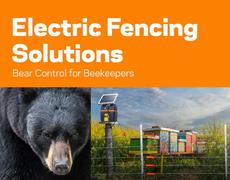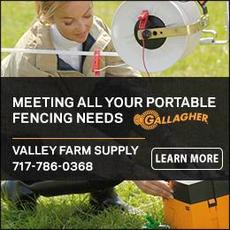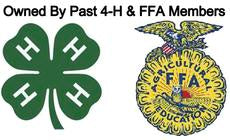February 09, 2017
February 08, 2017
Which components to buy and the type of electric fence
Considerations in Choosing Fencing
Which components to buy and the type of electric fence to build are determined by:
Species and ages of animals to be controlled
Range of soil moisture conditions
Amount of land to be fenced, as measured in length of fence times number of wires
Whether the fence will be permanent or temporary
Your budget
February 08, 2017
THE 20TH ANNUAL NORTHWEST PENNSYLVANIA GRAZING CONFERENCE
This year’s conference - Celebrating Milestones - will focus on tried and true and innovative methods applicable to grass-based farmers facing ever-changing environmental and economic conditions. Various experts will host sessions focused on the economics of a successful grass-fed beef operation, responsible management of pasture, and the economic and soil health benefits of integrating livestock into cropping systems and purchasing hay.
A brand new venue and some top-notch presenters will be just two of the many features to look forward to.
The conference will be held on Thursday, March 16, 2017 at the Trinity Point Church of God in Clarion, PA
Meet the Speakers...
KEYNOTE: Jim Gerrish - Jim Gerrish of May, Idaho is the owner of American GrazingLands Services, LLC which is dedicated to aiding farmers and ranchers to more effectively manage their grazing lands for economic and environmental sustainability. Jim’s experience includes over 20 years of beef-forage systems research and outreach while on the faculty of the University of Missouri, as well as 20 years of commercial cattle and sheep production on their family farm in northern Missouri. He was the co-founder of the popular 3-day grazing management workshop program at the University of Missouri’s Forage Systems Research Center. His research encompassed many aspects of plant-soil-animal interactions and provides a foundation for many of the basic principles of Management-intensive Grazing. Before moving to Idaho, Jim was deeply involved in the Green Hills Farm Project, a grassroots producer group centered in north-central Missouri and emphasizing sustainability of family farms. His research and outreach efforts have been recognized with awards from the American Forage and Grassland Council, Missouri Forage and Grassland Council, National Center for Appropriate Technology, USDA-NRCS, the Soil and Water Conservation Society, Progressive Farmer, and American Agricultural Editor’s Association. Jim is also a key instructor in the University of Idaho’s Lost River Grazing Academy held near Salmon, ID each June and September.
Dave White - Dave white enjoyed a 33-year career with NRCS, retiring as Chief of the Agency. He will discuss some of the milestones that forward thinking graziers and conservation-minded farmers have made in protecting our nation's resources.
Aaron & Melissa Miller - Aaron and Melissa Miller live in Kinsman, Ohio and are co-owners of Miller Livestock Co., Inc., They have been farming for nearly thirty-five years, and raising grass-fed and pastured livestock for direct-to-market sales since 1999. Aaron graduated from Ohio State University College of Agriculture with a degree in Animal Science. Miller Livestock produces approximately 90 head of cattle, 60 lambs, 200 hogs and 1000 birds each year which are marketed to local restaurants, butcher shops, schools, farmer’s markets, and directly to customers. Aaron and Melissa are also committed local food advocates who actively engage with customers and mentor new farmers.
Jay Fuhrer - Jay Fuhrer is a Conservationist employed by the Natural Resources Conservation Service in Bismarck, North Dakota. Graduating from North Dakota State University in 1976 with a degree in Agricultural Economics. He has had boots on the ground for the last 36 years working with cropping systems, grazing systems, and cover crops. Jay also has an extensive background working with many groups and entities such as soil and water conservation districts, no-till organizations, farm organizations, urban groups, and more. Currently, Jay spends his time at The Burleigh County Soil Conservation District’s Menoken Farm focusing on soil health and integrating livestock.
Baxter Black - Baxter Black is a rancher and retired large animal veterinarian from Benson, Arizona famous for his appearances on RFD-TV reciting his humorous and entertaining "cowboy poetry". He will NOT be at the conference but has graciously agreed to provide a pre-recorded video welcome of our 2017 conference attendees.
February 07, 2017
Compare cattle scale systems from Gallagher

Compare cattle scales here! Gallagher livestock and animal scale systems are high quality durable weighing options for your farm or ranch. Choose from the basic set up or buy EID compatible scale readers and indicators. Pick the best load bars to work under a squeeze chute or weigh cows on the alleyway platform Gallagher makes.
a durable scale for your operation means you can accurately dose cattle and livestock, saving stress and money. Healthy cattle and animals all benefit for you purchase of a cattle scale at www.gallagherelectricfencing.com
Order today and get free USA shipping and the best price around on Trutest or Gallagher weigh scales.
February 04, 2017
Southeast Pa Grazing Conference for 2017

February 04, 2017
Current Strategies in Parasite Control in Beef Cattle
Many advances have been made in the field of livestock parasite control over the past few years. Because parasites decrease production, usually through decreased weight gain, advances in the control of parasites can have a direct economic impact on beef cattle operations. Parasites that affect cattle can be divided into two major categories, internal and external.
Internal Parasites
Internal parasites which affect cattle include: roundworms, flukes, and tapeworms. Tapeworms are not considered to be of economic importance in cattle. Flukes are a problem in the Gulf Coast states and Pacific Northwest, but do not pose a major concern for Virginia cattle producers.
There are several different species of roundworms that can affect cattle in Virginia. Of these species, the one thought to be of most importance is Ostertagia, also known as the brown stomach worm. There are several aspects of this worm's life cycle that are important in designing a complete deworming program. Cattle are most susceptible to this worm at less than 2 years of age. Most cows greater than 2-3 years of age have developed immunity to this worm and do not show an economical benefit to deworming: However, deworming of cows can decrease the exposure of younger animals pastured in the same field.
Another important aspect of this roundworm's life cycle is its ability to go into hibernation in the abomasum, or true stomach, of cattle. This is commonly known as the inhibited larval stage of Ostertagia. This process can occur during the winter with these larvae maturing and developing into adult worms in the spring. While not common, large numbers of inhibited larvae can cause individual calves to show severe signs of parasitism, severe diarrhea, and rapid weight loss. This condition is known as Type II Ostertagiasis. Most but not all dewormers kill inhibited stage larvae.
Deworming
Dewormers for beef cattle come in several forms including paste, injectable, drench, pour-on, bolus, and as a feed or mineral additive. Products also have various lengths of activity and costs. See Table 1 for comparisons. Table 1. Dewormer products commonly used in Virginia
Strategic Deworming
Strategic Deworming involves developing a program with the goal of maximizing the economic benefit of deworming cattle while also removing the larvae from infected pastures. Animals have often been dewormed at the start of the grazing season and at the end, but this is insufficient. One deworming in the spring is not cost effective because it does not prevent a buildup of the worm burden later in the grazing season. Deworming in the fall may prevent the "sleeping" larvae from doing damage the following spring; however, this is only the case if the right drug is used and cattle are kept off contaminated pastures following deworming.
Newer deworming programs, based on current knowledge of the persistent activity of dewormers, provide for much greater benefits of deworming. Studies have shown that strategic deworming programs can provide 30-100 extra pounds of gain per grazing season. In order to be most effective, these programs should start when cattle are first turned on to pastures to graze in the spring, with subsequent dewormings depending on the length of persistent activity of the chosen dewormer (See Table 1). Studies have also shown that an adjusted strategic deworming program can be accomplished by deworming at turnout and midsummer.
External Parasites
External parasites which affect cattle include lice, warbles (grubs) and flies. Lice are most commonly a problem in late winter, affecting both younger animals and adult cows. The primary clinical signs of lice are severe itching and hair loss, primarily around the neck and tailhead. The entire life cycle of the louse is spent on the animal's body, making development of a control program easier. There are three stages of the louse's life cycle: (a) nit (egg), (b) larva, (c) adult. All products kill both the larvae and adult stages, but no products kill the nit. In order to completely eradicate lice from a herd of cattle, they must be treated with the product twice 2 weeks apart or treated with a product that has greater than 2 weeks persistent activity. Lice problems will typically clear up as temperatures rise in late spring and early summer, but they can cause decreases in body condition and milk production if severe enough.
Grubs (warbles) are the larval stage of the heel fly that migrates from the animal's heel (where the eggs are deposited by the adult fly in early summer) to the back of the animal. These larvae can cause damage to the hide of the animal and if treated during the wrong time of the year can cause paralysis due to their location near the spinal column. Cattle should not be treated with grubicide between November 15 and March 1.
Flies are probably the most common nuisance and have the largest economic impact of the external parasites. The 2 major types of flies are face flies and horn flies. Both of these types of flies cause decreased weight gain in cattle. The two major classes of chemicals currently being used to control flies include pyrethrins and organophosphates. There are several different methods available for applying the insecticides. These include:
Fly Tags - May contain either pyrethrins or organophosphate compounds or both together.
Pour-ons - Have different formulations that provide protection from known resistant fly populations for 2-11
weeks.
Back Rubs - Concentrates of either pyrethrins or organophosphates can be mixed with diesel fuel and applied to the back rub (Must be placed in a high traffic area).
Spray Applicators on Mineral Feeders - Sprays a small amount of chemical on the animal when it sticks its head in the mineral feeder.
Hand Sprayers - Concentrates can be mixed up in sprayers and applied to cattle 2-4 times a month. Because flies can develop resistance to products that contain pyrethrins and those containing organo-phosphates, rotation between the two types of insecticides on an annual basis is thought to reduce the likelihood of the development of resistant fly populations.
January 31, 2017
How to set up poultry, sheep or goat netting fence
-
Undo the 3 tie cords wrapped around the netting. These cords will be used as corner ties (Step 5). Holding all of the posts together in your hands, let the net drop to the ground. The long cord in the bag is used to tie back the end post (Step 4) if the net is setup in a square or rectangular shape.
-
Stick the end post into the ground with 1 hand while holding the bundle of posts with the other.
-
Walk along the proposed fence line, laying line posts on the ground. Stop where you want to make a corner. Go back to the rst post and set up the posts to the corner. Proceed to the next corner and repeat the set up.
-
When all the line posts are in line, insert the last post into the ground and secure it with the white cord and metal anchor stake. The white tie cord is 10’ long. Tie a loop in the middle of the cord to go over the top of 1 end post. Stake the 2 cord ends to the ground, parallel to the direction of the fence lines.
-
The corners are supported by tying down the corner posts at a 45° angle with a black cord and metal anchor stake.
-
Anchor the bottom strand of the net to the ground between posts with the metal anchor stakes. Connect the fence charger to the metal clip at the end of the net. An alligator clip works well for this connection. Use the metal clips to connect multiple nets together. Tie the tops of the 2 end posts together with 1 of the clip cords.
-
To dismantle the netting, pull out all the posts and lay them on the ground. Walk along and collect the posts.
-
Roll the netting toward the posts and secure with ties.
January 28, 2017
ELECTRIC FENCE POULTRY, SHEEP, GOAT NETTING INSTALLATION GUIDE
Final Check:
After the netting has been set up, hang the fence charger under the eave of a building or somewhere where weather won’t affect the unit. Connect insulated, high-voltage wire to the metal connector that hangs down from the rest line post, and connect the other end to the red lead that’s on the fence charger. If there is a lot of traffic in between these connections, it is recommend that you bury the wire underground. Pound the ground rod into the ground near your charger. Connect the galvanized wire to the ground rod using the clamp, and connect it to the black lead on the fence charger. Plug the unit in. If you have a fence tester, test the fence at the furthest point from the charger to make sure you have adequate grounding in the fence. Additional ground rods may be needed in rocky, sandy soils that do not hold moisture well.
January 24, 2017
Animal Ownership | what you should know
Animal rights extremists like the Humane Society of the United States (HSUS), People for the Ethical Treatment of Animals (PETA), and the Animal Liberation Front (ALF) seek to put an end to animal ownership. In their eyes, animals should share rights with humans and some of the most extreme among them equate animal ownership to slavery. Their goal of abolishing animal ownership and animal breeding is an extreme view not known by many.
For almost half a century, animal rights extremists have put considerable funding behind efforts to end animal entertainment and competitions. They have pursued legislation, deployed propaganda, lobbied Congress, and distorted the truth, as they continually harass entertainers and animal competition organizations. This includes rodeo events, horse shows, animals in movies, and dog shows, among other things.
Unfortunately, they have quietly been making progress. They need to be stopped. The first step to stopping these radical organizations and their activities is by being informed.
Sign up for our newsletter: http://protecttheharvest.com/newsletter-sign-up/
January 24, 2017






